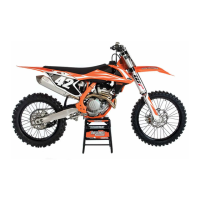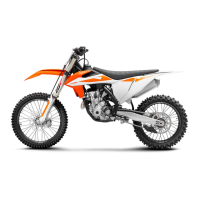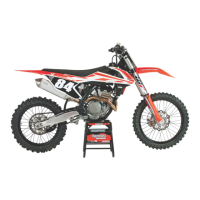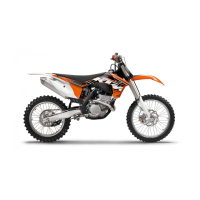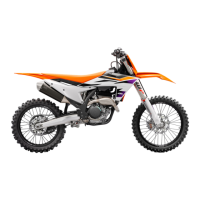
Do you have a question about the KTM 250 SX-F 2023 and is the answer not in the manual?
| Engine Type | 1-cylinder, 4-stroke engine |
|---|---|
| Bore x Stroke | 78 mm x 52.3 mm |
| Compression Ratio | 14.4:1 |
| Starter | Electric starter |
| Transmission | 5-speed |
| Fuel System | Keihin EFI, throttle body 44 mm |
| Cooling | Liquid cooled |
| Ignition | Keihin EMS |
| Front Suspension | WP XACT-USD, Ø 48 mm |
| Rear Suspension | WP XACT Monoshock with linkage |
| Front Brake | Disc brake |
| Rear Brake | Disc brake |
| Front Tire | 80/100-21 |
| Ground Clearance | 370 mm |
| Displacement | 249.9 cm³ |
| Final Drive | Chain |
| Frame | Central double-cradle type 25CrMo4 steel |
| Rear Tire | 100/90-19 |
| Front Wheel | 1.60 x 21 |
| Rear Wheel | 2.15 x 19 |
| Wheelbase | 1, 485 mm ± 10 mm |
Explains the meaning of various symbols used in the manual.
Defines the typographical formats used for names and terms.
Covers intended use, misuse, general safety instructions, and risk symbols.
Details warnings on tampering, safe operation guidelines, and protective clothing.
Provides rules for working on the vehicle, environmental considerations, and manual importance.
Covers warranty, fuel, parts, service, figures, and customer service.
Illustrates and labels the front left view of the motorcycle.
Illustrates and labels the rear right view of the motorcycle.
Details the location of VIN, steering head label, and engine number.
Specifies the location of fork and shock absorber article numbers.
Identifies clutch lever, hand brake lever, throttle grip, and stop button.
Explains the start button, combination switch, and indicator lights.
Describes the combination instrument and fuel tank cap operation.
Details cold start button, idle speed adjustment, shift lever, and stands.
Provides guidance for first use, including safety precautions.
Explains engine break-in procedures and lithium-ion battery care.
Covers vehicle preparation for various challenging conditions.
Details pre-ride checks and procedures for starting the engine.
Explains how to activate launch and traction control systems.
Provides instructions on shifting, riding, and applying brakes.
Covers procedures for stopping, parking, transporting, and refueling.
Provides information on service intervals and additional notes.
Lists specific maintenance tasks and their intervals.
Covers chassis setting based on rider weight and air suspension.
Details adjustments for low-speed and high-speed compression damping.
Explains how to measure and adjust static and riding sag.
Covers fork setting, air pressure, and damping adjustments.
Describes how to adjust the handlebar position for comfort.
Procedures for using a lift stand and removing the motorcycle.
Details bleeding fork legs and cleaning dust boots.
Covers checking and adjusting steering head bearing play.
Explains the removal and installation of the shock absorber.
Covers air filter removal, cleaning, installation, and silencer work.
Details fuel tank service and chain maintenance procedures.
Covers frame, link fork, and throttle cable routing checks.
Provides instructions for changing hydraulic clutch fluid.
Covers checking hand brake lever travel and brake discs.
Details checking and adding front brake fluid and linings.
Covers checking and adjusting foot brake lever travel.
Details checking and adding rear brake fluid and linings.
Provides instructions for removing and installing the front wheel.
Details the removal and installation of the rear wheel.
Covers checking tire condition, age, and pressure.
Explains how to check and correct spoke tension.
Covers removing, installing, and charging the 12-V battery.
Details changing the main fuse and fuel pump fuse.
Identifies the location of the diagnostics connector.
Covers checking antifreeze and coolant levels in the system.
Provides procedures for draining, refilling, and changing coolant.
Details checking and adjusting play in the throttle cable.
Explains how to adjust the characteristic map of throttle response.
Covers changing engine mapping and adjusting idle speed.
Describes programming the throttle valve position.
Covers checking and adjusting the shift lever's basic position.
Details the procedure for changing the fuel screen.
Covers checking engine oil level and changing oil/filter.
Provides instructions for adding engine oil.
Provides guidelines for safely cleaning the motorcycle.
Details steps for preparing the motorcycle for long-term storage.
Outlines procedures for returning the motorcycle to use after storage.
Lists common engine start and running problems and their solutions.
Addresses malfunction indicator lamp and high oil consumption.
Lists blink codes for various malfunction indicator lamp conditions.
Provides detailed technical specifications for the engine.
Lists torque specifications for various engine components.
Details fluid capacities and chassis-related specifications.
Provides data for electrical system components and tires.
Lists technical data and settings for the front fork.
Details technical data and settings for the rear shock absorber.
Lists torque specifications for chassis components.
Specifies standards and recommended suppliers for fluids.
Details specifications for fork oil, fuel types, and other fluids.
Lists recommended suppliers and products for cleaning and lubrication.
Details special cleaners, greases, and sprays.
Explains JASO T903 MA2 and SAE viscosity standards for oils.
Provides definitions for terms like Launch Control, OBD, and Quickshifter.
Lists common abbreviations used in the manual.
Explains the meaning of yellow, orange, green, blue, and white symbols.




